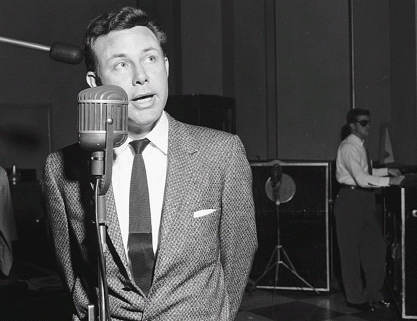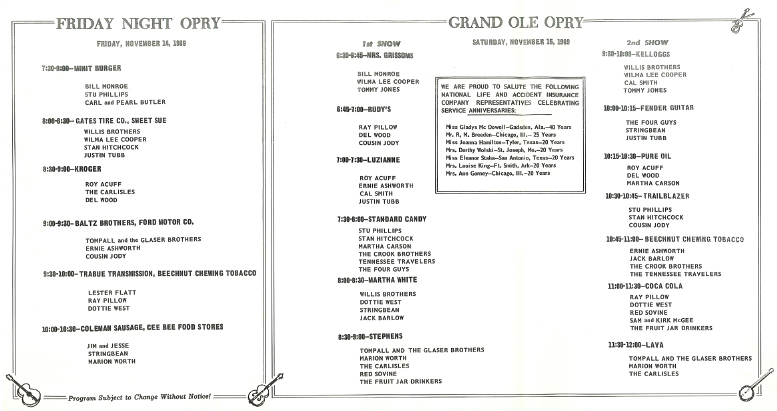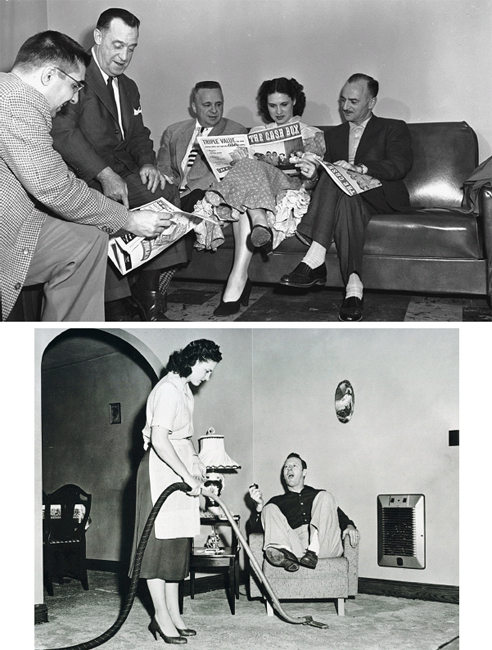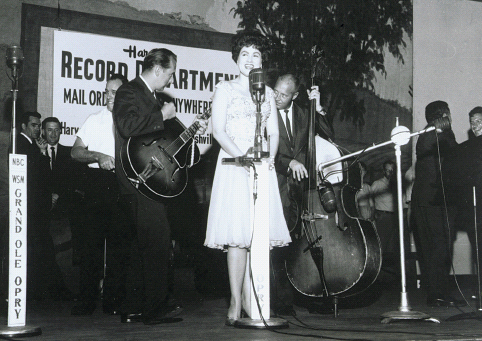The Grand Ole Opry (26 page)
Read The Grand Ole Opry Online
Authors: Colin Escott

BILL ANDERSON:
Country music came back, but it didn’t come back as “Wreck on the Highway” or “In the Jailhouse Now.” It came back as “I Can’t
Stop Loving You.”
With several Nashville Sound pioneers in the cast, D. Kilpatrick decided to make another play for prime-time television. In
April 1957, he.helped write a proposal to ABC-TV. The Opry had been on ABC-TV briefly in 1955–56, but, with the advent of
the Nashville Sound, Kilpatrick believed that it was time to try again.

Jim Reeves
WSM proposal to ABC:
The dividing lines between categories, eg. Pop, country, rock-and-roll, are vanishing. April 1957 is the month and the year
of the “new formula” for hit songs. It is a formula composed of one part country, one part rock-and-roll, and one part pop.
It is a formula whose mainstay is the country musician whose trademark is the small instrumental combination, and whose success
is so certain that every recording studio in Nashville has been working night and day with recording stars and A&R men moving
into the city from both coasts. Patsy Cline’s “Walking after Midnight” sold 400,000 records in 14 days! And she is a country
artist. The mastery of this new formula is precisely the trump card which has shot many Grand Ole Opry stars into even greater
prominence.
ABC-TV didn’t go for the Opry’s pitch, but the Opry’s attendance slowly increased as country music itself rebounded. And Kilpatrick
had made his point: the Nashville Sound was okay; rock ’n’ roll was not.
Journalist
BILL MAPLES,
“Country Music Goes Country” in the
Tennessean,
May 18, 1958:
The Grand Ole Opry may be one of the most persuasive forces in the revival of country music. In the first place, rock ’n’
roll is not allowed there. Some time ago, the Wilburn Brothers came on-stage in tuxes and sang one of their latest releases.
“Ooh Bop Shee Boom.” After the performance, which was admittedly as good as rock ’n’ roll gets, D. Kilpatrick told the boys
not to sing that particular song on the Opry again. Later, he explained to me why he’d taken this stand. “I can show you a
huge file of critical letters we’ve received after doing such songs on the Opry,” he said. “WSM has operated very successfully
with country music for 33 years. We figure that if we stay with country music, we’ll be here another 33 years. Besides, when
the crowd gets to the Ryman on Saturday night expecting to hear country music and it hears rock ’n’ roll instead it’s like
a bunch of fans going to Sulphur Dell expecting to see a baseball game and finding a mumble-peg match instead.”
The
Nashville Banner,
November 10, 1958:
Because the Grand Ole Opry lives:
Nashville is Music City USA, trailing only Hollywood and New York in providing music for the world. (2) The community has
some 3,000 or more residents who can trace their livelihood to the music industry. (3) Approximately $5,000,000 in fast-circulating
tourist dollars come into this community every year with the 250,000 visitors attending the Opry.

G
RAND
O
LE
O
PRY
NEW MEMBERS: 1960s
B
ILL
A
NDERSON
E
RNIE
A
SHWORTH
B
OBBY
B
ARE
T
HE
B
ROWNS
P
ATSY
C
LINE
J
IMMIE
D
RIFTWOOD
T
HE
F
OUR
G
UYS
T
HE
G
LASER
B
ROTHERS
J
ACK
G
REENE
G
EORGE
H
AMILTON
IV
S
ONNY
J
AMES
J
IM
AND
J
ESSE
H
ANK
L
OCKLIN
B
OBBY
L
ORD
B
OB
L
UMAN
L
ORETTA
L
YNN
W
ILLIE
N
ELSON
N
ORMA
J
EAN
T
HE
O
SBORNE
B
ROTHERS
D
OLLY
P
ARTON
S
TU
P
HILLIPS
R
AY
P
ILLOW
D
EL
R
EEVES
T
EX
R
ITTER
J
EANNIE
S
EELY
C
ONNIE
S
MITH
L
EROY
V
AN
D
YKE
B
ILLY
W
ALKER
C
HARLIE
W
ALKER
D
OTTIE
W
EST
M
ARION
W
ORTH

“A FRIEND OF A FRIEND OF MINE IS A FRIEND OF OTT DEVINE”
I
n 1959, D. Kilpatrick left the Opry to join Acuff-Rose. His replacement, Ottis “Ott” Devine, had been with WSM since 1935.
In 1957, Devine had replaced Jack Stapp as WSM program director before taking over the Opry as well. The dust had settled.
The Grand Ole Opry might not have been the force within the industry that it once was, but it was still the dream of everyone
who sang country music. Ott Devine lowered the Saturday night commitment required for Opry membership, but held fast to that
commitment. He managed the show for nine years, signing several artists who would become Opry mainstays, including Patsy Cline,
Loretta Lynn, Bill Anderson, Jan Howard, Bobby Bare, Willie Nelson, Jim and Jesse, Connie Smith, Dottie West, and Jack Greene.
The Opry’s cautious approach to change was never more apparent than in its attitude toward women. There had been women on
the Opry from the very first night when Eva Thompson accompanied Uncle Jimmy Thompson, but the Opry’s first female singing
star was Kitty Wells. Kitty sang her finger-pointing hit, “It Wasn’t God Who Made Honky Tonk Angels,” in a very unthreatening
way, and her below-the-knee gingham gowns remained her trademark. She was a reluctant star, and her husband, Johnnie Wright
of Johnnie & Jack, managed her career and pushed her into the spotlight.
Kitty Wells made her living in a business overwhelmingly dominated by men . . .
. . . while projecting an image of domesticity.
KITTY WELLS:
Roy Acuff once informed Johnnie that a woman should not be starred in a country act because they couldn’t carry the show.
Johnnie told Roy, “Well, we’re just gonna try it.”
Jean Shepard joined the Opry in 1955, and stayed. Aside from Kitty Wells and Minnie Pearl, the only other female solo act
in the cast at the time was pianist Del Wood. Others came but didn’t stay. Rockabilly queen Wanda Jackson made just one appearance,
and Rose Maddox stayed only a few months. Like Jean Shepard, they’d launched their careers in western dance halls, but unlike
her, they found the Opry to be a hard adjustment.
WANDA JACKSON:
I was just getting ready to go on in one of my new sexy little white and red fringe outfits, and Ernest Tubb said, “Are you
Wanda Jackson? You’re on next, hun.” I said, “Okay, I’m ready.” He said, “Well, you can’t go on the stage at the Opry like
that. You can’t show your shoulders!” So I went back and I happened to have a pretty decent white leather fringe jacket that
I put on, but I was near tears. I came out of there and I said, “I’ll never come back to this place again!”
ROSE MADDOX:
I had a costume made for my record “Tall Man.” Blue satin skirt with silver fringe, bare midriff, long sleeves with the silver
fringe, boots, neckerchief, and cowboy hat. I thought the Opry would come apart. The bosses nearly come unglued. Whenever
I saw Minnie Pearl after that, she’d say, “Every one of them Opry bosses jumped on me. ‘Why’d you let her do that?’ ”
A December 1959 memo to performers from D. Kilpatrick confirmed that there really was a dress code, even if it wasn’t very
clear. “It is suggested that female performers dress more in keeping with the show,” wrote Kilpatrick, “and, when possible,
the use of a guitar or another instrument is suggested.”
But a new addition to the Opry stage was soon to change the policy on attire for female performers.
OTT DEVINE:
I was standing onstage watching one of the performers when Patsy came up behind me and said a bit hesitantly, “Mr. Devine,
do you think I could ever become a member of the Grand Ole Opry?” Of course I knew of her talent. I had heard her sing. She
had a beautiful voice. And so I replied. “Patsy, if that’s all you want, you are on the Opry.”
Signing Patsy Cline seems like an easy decision, but when she joined the Opry in 1960, she’d had just one hit, “Walkin’ after
Midnight,” and that was three years earlier. Her career was at its lowest ebb, and she told her family and booking agent to
leave messages for her at the Opry because she couldn’t afford the fifty dollars to get a phone connected. The following year,
though, she signed with Decca Records, and her first Decca record, “I Fall to Pieces,” became a number-one country hit.

Patsy Cline.
After Patsy joined the Opry, she went home and typed out her biography for the Opry’s news service.
Married to Charles Dicks and have one little girl . . . Julia Simadore (Bible name). Living at 213 East Marthona Road . .
. off of Old Hickory . . . out Gallatin Road . . . Madison Tennessee (buying home) Neighbor to Hank Snow. Husbnad [sic] .
. . lineatype operator . . . he works. Curley Printing Co. I don’t want to get rich . . . just live good.
